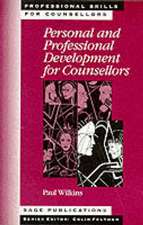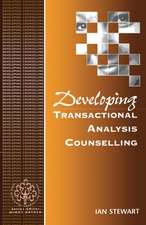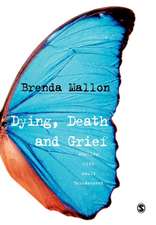Common Presenting Issues in Psychotherapeutic Practice
Autor Barbara Douglas, Pam Jamesen Limba Engleză Paperback – 15 dec 2013
With the support of expert contributors, Pam James and Barbara Douglas help your students to confidently do just that, proving a comprehensive introduction to the theory, research and practice behind a range of common presenting issues. Key issues covered include:
- Anxiety
- Depression
- Trauma
- Bipolar disorder
- Psychosis
- Eating disorders
- Borderline personality disorder
This book should be on the desk of every counselling, psychotherapy and counselling psychology trainee, and is recommended reading for other practitioners of health and social care working with these common presenting issues.
Preț: 378.16 lei
Nou
Puncte Express: 567
Preț estimativ în valută:
72.37€ • 75.28$ • 59.75£
72.37€ • 75.28$ • 59.75£
Carte tipărită la comandă
Livrare economică 14-28 aprilie
Preluare comenzi: 021 569.72.76
Specificații
ISBN-13: 9781446208540
ISBN-10: 1446208540
Pagini: 200
Ilustrații: black & white illustrations, figures
Dimensiuni: 170 x 242 x 11 mm
Greutate: 0.36 kg
Ediția:1
Editura: SAGE Publications
Colecția Sage Publications Ltd
Locul publicării:London, United Kingdom
ISBN-10: 1446208540
Pagini: 200
Ilustrații: black & white illustrations, figures
Dimensiuni: 170 x 242 x 11 mm
Greutate: 0.36 kg
Ediția:1
Editura: SAGE Publications
Colecția Sage Publications Ltd
Locul publicării:London, United Kingdom
Recenzii
For too long Counselling Psychology perspectives to understanding human distress have been drowned out by medical and clinical voices. This book challenges this, adding as it does to the emerging literature offering reflection and debate as to what a human – and humane - approach to such distress might be. By reflecting on the dilemmas embedded in this area this book offers a rare chance to think meaningfully about distress rather than simply ‘do something’ to it.
I believe that this book makes a really useful and timely contribution to the literature and therefore potentially to clinical practice. It will be valuable to psychologists, psychotherapists, psychiatrists and others engaged in therapeutic practice in a wide range of contexts. It combines elements of critical thinking with a real depth of clinical experience and a useful selection of examples. The book contains contributions from both the authors and a range of clinicians with many years of experience. Each of the authors deconstructs some of the difficulties and dilemmas associated with the use of diagnostic categories and considers the contextual factors which are at play. The structure of the book is very helpful in that each chapter gives a historical perspective on a particular diagnostic category; this is followed by a discussion of the real life dilemmas in clinical practice, followed by a section which explores research and practice with service users labelled with this diagnostic categorisation. The reflection box at the end of each chapter is particularly useful as it will enable individuals or groups to consider and reflect upon the issues raised in the preceding chapter. I believe this book will be a real asset to the work of a range of professionals and will stimulate debate and critical thinking which can only ultimately benefit the service user and the delivery of psychological and therapeutic services.
This is an excellent and timely evaluation of some of the most common presenting problems faced by the contemporary psychological therapist. What makes this book so unique is constant linking between theory and practice, allowing the reader true insight into the thinking behind the conceptualisation of distress as well as how to work with it effectively in the consulting room. The book will appeal to students, practitioners and academics alike.
For me, a therapist but not a psychologist, the book’s greatest strength was the insight it gave me into the breadth of counselling psychology practice and the inclusion by the authors of multiple perspectives in their interventions with clients. It is, I would suggest, essential reading for counselling psychologists and may also be of interest to other therapists.
This insightful book [...] should be in the library of every counselling, psychotherapy and counselling psychology practitioner, whether experienced or in training [...] This is a thoroughly refreshing read that validates the importance of keeping the client in mind and providing a type of care that is individual, attuning and compassionate via the therapeutic relationship.
I believe that this book makes a really useful and timely contribution to the literature and therefore potentially to clinical practice. It will be valuable to psychologists, psychotherapists, psychiatrists and others engaged in therapeutic practice in a wide range of contexts. It combines elements of critical thinking with a real depth of clinical experience and a useful selection of examples. The book contains contributions from both the authors and a range of clinicians with many years of experience. Each of the authors deconstructs some of the difficulties and dilemmas associated with the use of diagnostic categories and considers the contextual factors which are at play. The structure of the book is very helpful in that each chapter gives a historical perspective on a particular diagnostic category; this is followed by a discussion of the real life dilemmas in clinical practice, followed by a section which explores research and practice with service users labelled with this diagnostic categorisation. The reflection box at the end of each chapter is particularly useful as it will enable individuals or groups to consider and reflect upon the issues raised in the preceding chapter. I believe this book will be a real asset to the work of a range of professionals and will stimulate debate and critical thinking which can only ultimately benefit the service user and the delivery of psychological and therapeutic services.
This is an excellent and timely evaluation of some of the most common presenting problems faced by the contemporary psychological therapist. What makes this book so unique is constant linking between theory and practice, allowing the reader true insight into the thinking behind the conceptualisation of distress as well as how to work with it effectively in the consulting room. The book will appeal to students, practitioners and academics alike.
For me, a therapist but not a psychologist, the book’s greatest strength was the insight it gave me into the breadth of counselling psychology practice and the inclusion by the authors of multiple perspectives in their interventions with clients. It is, I would suggest, essential reading for counselling psychologists and may also be of interest to other therapists.
This insightful book [...] should be in the library of every counselling, psychotherapy and counselling psychology practitioner, whether experienced or in training [...] This is a thoroughly refreshing read that validates the importance of keeping the client in mind and providing a type of care that is individual, attuning and compassionate via the therapeutic relationship.
Cuprins
Foreword - Professor Ray Woolfe
Introduction (with Carol Lund) - With a contribution from Dr Carole Lund
Exploring anxiety (with Mary Reid) - With a contribution from Dr Mary Reid
Exploring depression (with Dee Danchev) - With a contribution from Dr Dee Danchev
Exploring trauma and post traumatic stress (with Tony Parnell) - With a contribution from Anthony Parnell
Exploring psychosis (with Hamilton Fairfax) - With a contribution from Hamilton Fairfax
Exploring bipolar (with Roly Fletcher) - With a contribution from Dr Mabel Martinelli
Exploring the borderline (with Clare John and Nicola Gale) - With a contribution from Nicola Gale and Dr Claire John
Exploring eating disorders (with Amanda Hall) - With a contribution from Amanda Hall
Conclusion (with Sheelagh Strawbridge) - With a contribution from Sheelagh Strawbridge
Introduction (with Carol Lund) - With a contribution from Dr Carole Lund
Exploring anxiety (with Mary Reid) - With a contribution from Dr Mary Reid
Exploring depression (with Dee Danchev) - With a contribution from Dr Dee Danchev
Exploring trauma and post traumatic stress (with Tony Parnell) - With a contribution from Anthony Parnell
Exploring psychosis (with Hamilton Fairfax) - With a contribution from Hamilton Fairfax
Exploring bipolar (with Roly Fletcher) - With a contribution from Dr Mabel Martinelli
Exploring the borderline (with Clare John and Nicola Gale) - With a contribution from Nicola Gale and Dr Claire John
Exploring eating disorders (with Amanda Hall) - With a contribution from Amanda Hall
Conclusion (with Sheelagh Strawbridge) - With a contribution from Sheelagh Strawbridge
Notă biografică
Descriere
With the support of excellent contributors, Pam James and Barbara Douglas help students to learn to develop the skills and knowledge required to work effectively with a range of common presenting issues in psycotherapeutic practice, from anxiety to borderline personality disorders.










